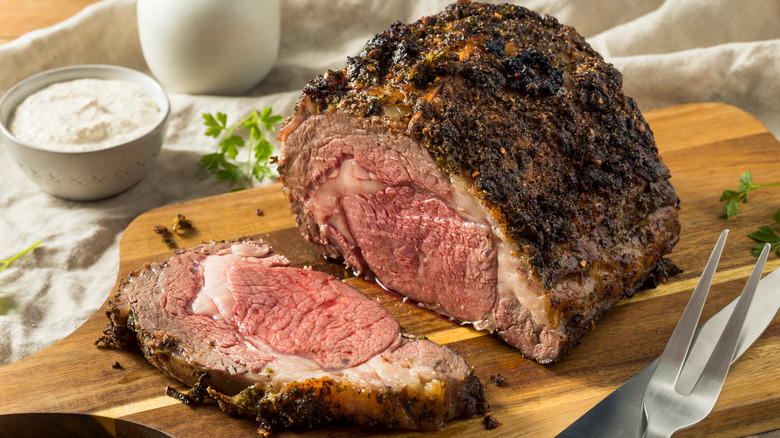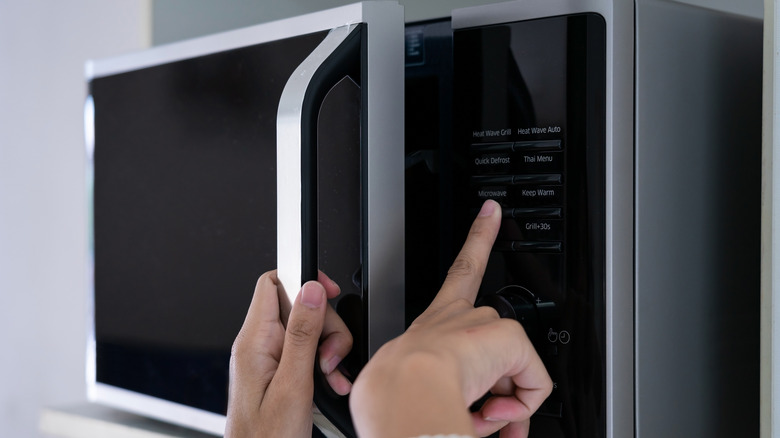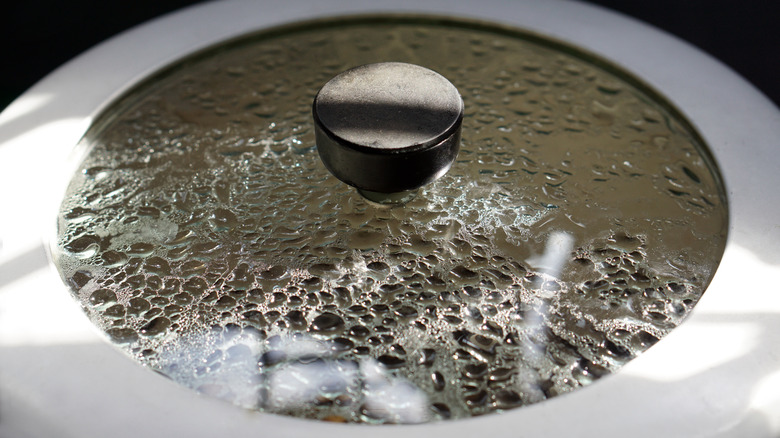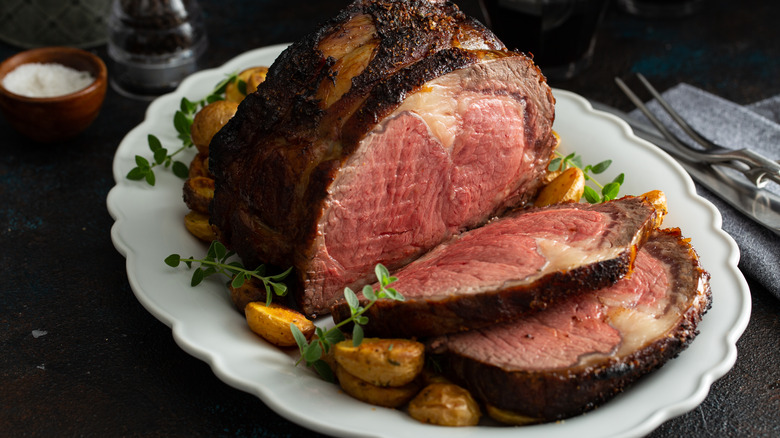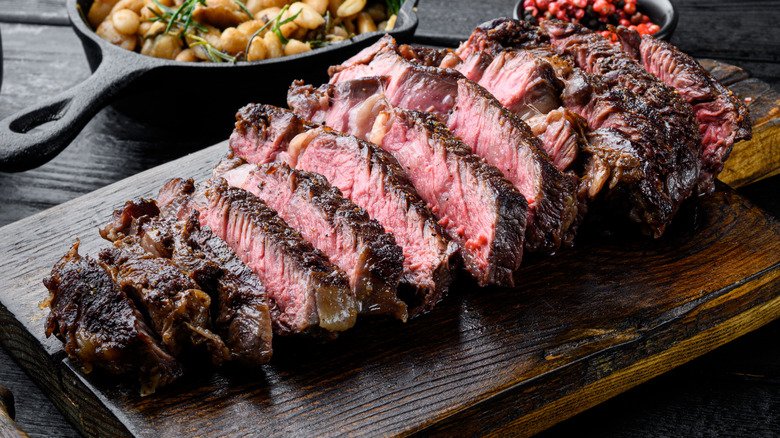You've Been Reheating Prime Rib Wrong Your Whole Life
Quick question. Who amongst us (with the exception of vegetarians and vegans) doesn't love the incredibly tender prime rib? It wouldn't be wrong to say that prime rib, aka a standing rib roast, is hands down one of the best crowd-pleasers on any given occasion, especially holiday dinner parties. Some would say that the "prime" of beef cuts is none other than a prime rib. The Kitchn beautifully describes prime rib as the "undisputed king when it comes to a large cut of beef."
One thing we know for sure is that there's nothing quite like savoring every succulent bite of this flavorful juicy hunk of meat. Since this better cut of meat is usually high in demand and expensive at steakhouses, you can always try the surprisingly good and less costly homemade prime rib recipe. Just make sure to keep one important rule in mind when buying prime rib at the grocery store.
Given that one serving of this special meal is huge, leftovers become inevitable since we don't want any of this wondrous meat to go to waste. However, reheating prime rib can be tricky as you don't want to lose the tender juiciness of this prized cut of beef. So don't fret — we've got some great ways for you to reheat prime rib!
The microwave
Let's start with a super easy prime rib reheating method that is ideal for busy people. Professional cooking experts don't recommend this option too often since it has a bad reputation for sucking the juiciness of prime rib and other amazing foods (yep, we're talking about pizza). If that is the case, why on earth are we recommending you to try this method? Well, as it turns out, a microwave is a pretty decent prime rib reheating option as long as you use it the right way. There's also one microwave trick that makes evenly reheating leftovers easy.
The trick to reheating prime rib in a microwave revolves around adding more moisture in the form of a few tablespoons of broth. Place evenly cut prime rib slices in a microwave-safe dish and pour a few tablespoons of beef broth over them. Next, cover the dish and heat the leftover prime rib slices for one to two minutes (via Epicurious). Make sure to serve the reheated dish right away instead of letting it overheat. However, we must say that it would be best to consider this method as a last resort.
Using a steamer
If you've ever tried to reheat prime rib and found it bland or dull, you won't feel the same after trying the steamer method. Steaming is a highly recommended way of reheating since it helps lock in meat moisture. BBC Good Food finds it a far gentler form of cooking that is ideal for retaining the flavor and texture of all foods. Though it's not as convenient or fast as the microwave, it gets the job done.
The steamer method works well for sliced prime rib instead of an entire roast. Pour some water into a pot and start boiling it (let it simmer). Next, wrap the leftover prime rib and its juices in an aluminum foil and place it into the steamer basket. Cover the pot and steam the meat for three to six minutes. Afterward, you can unwrap the foil and use a meat thermometer to check that it's heated properly (recommended temperature is 160-165 degrees Fahrenheit). If you notice that it's not warmed enough, rewrap the soon-to-be-devoured meat and steam for about two minutes more. Once ready, transfer it to a serving dish straightaway to avoid overcooking.
Go with the oven reheating option
When you want to chow down a delicious leftover prime rib, reheating it could be a huge fail if you don't follow a proper reheating process. Moreover, the reheating leftover method you choose can either breathe life back into your pre-cooked meal (along with some health benefits) or suck the little remaining life out of it. One such reheating method is using an oven, but many people mistakenly overcook the meal by turning the oven on full blast. Nevertheless, it's an excellent way to reheat sliced prime rib or even a whole roast.
The first thing you need to do is preheat the oven to 250 degrees Fahrenheit. Place the prime rib in a baking pan and pour a few tablespoons of beef broth (adding water works fine, but it will weaken the flavor). Use aluminum foil to tightly cover the meat and place the baking pan in the oven. Check after 10 minutes and if it's not fully heated, give it another go of three minutes before serving it. Many people use this trick since it pretty much helps achieve the original ideal pink color and taste of the prime rib.
There are other methods for reheating prime rib
If all else fails to deliver what you wanted, there are other methods you can try. For instance, you can go for reheating prime rib with an air fryer. Yes, you read that right. You just need to preheat the air fryer to 200 degrees Fahrenheit. Pour a few tablespoons of au jus over your prized prime rib and wrap it up in aluminum foil. Next, raise the temperature to 300 degrees Fahrenheit and let the small oven reheat the meat for 10 minutes (per Lacademie).
You can also try the stovetop reheating method that uses a steamer basket. Add about two to three inches of water into the pot and place the steamer basket over it. When the water simmers, place aluminum foil-wrapped prime rib in the basket and cover it. Let the steam heat the meat for three to six minutes, and there you have it (via Southern Living).
And if you're not in the mood for reheating, you can always eat it cold. You can use thinly sliced prime rib pieces in salads or a delicious easy roast beef sandwich recipe.
